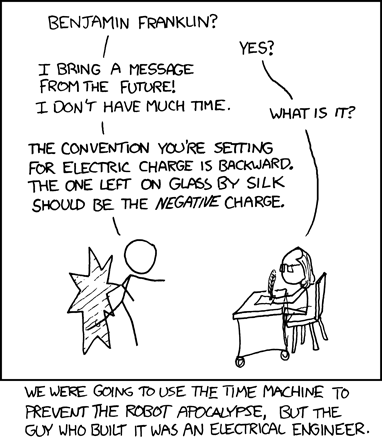Recent searches
Search options
Why do we call electrons 'negative' and protons 'positive'? It's an arbitrary convention but it's annoying: it means that when electrons flow through wires, the current is defined to flow in the OTHER DIRECTION.
If you ask people why electrons got called 'negative', you get a bunch of crap answers:
"Electrons are referred to as negative because of their behavior in an electric field. In an electric field, an electron will move from the negative pole to the positive pole, giving it a negative charge by convention."
Yes, but why THAT convention?
"If we re-designate all positive electric charges as negative and vice versa, while keeping their absolute value, the resulting physics would be the same. So exact choice is merely a matter of convention."
Yeah, it's a convention - but why THAT convention?
"In quantum theory of elementary particles (in a sense of irreducible representation of Poincare group with mass m and spin (helicity) s) if some operator Q of internal symmetry commutes (like electric charge charge) with Hamiltonian H...."
Irrelevant crap which never leads up to an answer.
The answer is that Benjamin Franklin chose this convention and nobody knows why.
In Franklin's day there was a 'two-fluid' theory of electricity saying electricity comes in two kinds. Around 1750 he developed a 'one-fluid' theory after showing that a rubbed glass receives an equal but opposite charge as the cloth used to rub the glass. He decided that electrical fluid was going into the glass. So he said the charge of the glass was 'positive' and the cloth was 'negative'.
Unfortunately it turns out that that electrons are going into the cloth.
The whole history is interesting:
@johncarlosbaez It could have been worse. Imagine if a Frenchman, say, had been working on the same things at the same time, only with the opposite convention, and French physicists then stubbornly stuck with it to this day while everybody else followed Franklin.
@mansr
The ones stubbornly using weird units are the people in the US, not the French
@johncarlosbaez
@j_bertolotti @mansr @johncarlosbaez
The French also use a crazy system. The base unit of distance is metres (Earth's circumference/40,000 to make it roughly equivalent to a yard) but don't lead directly to volume in litres, you have to remember to do your measurements in decimetres. The unit of weight isn't the gramme but the thousand-gramme (kilogramme). Instead of a cube of sides 1 metre containing one litre and that volume of water weighing 1 gramme, it weighs 1 thousand thousand-grammes. ;)
@geoffl They also use time units where 1 minutes is 60 seconds instead of a nice power of 10. And don't get me started on the day being 24 hours!
@j_bertolotti @geoffl - The French had the right attitude but they couldn't make it stick: "The French Republican calendar time system used in France from 1794 to 1800, during the French Revolution, divided the day into 10 decimal hours, each decimal hour into 100 decimal minutes and each decimal minute into 100 decimal seconds (100000 decimal seconds per day)."
https://en.wikipedia.org/wiki/Decimal_time
Decimal angles too:
"But a second proposal suggested changes went further still. On 1 November 1795 (11 brumaire by the new calendar) a law was passed which required the creation of clocks with ten hours in the day, 100 minutes in an hour, and 100 seconds in a minute. A metric system of angles was also brought in, with 400 degrees in a full turn (100 degrees in a right angle). Now the earth would rotate 40 degrees in an hour and, since the metre had been designed so that one quarter meridian was 10 million metres, each degree of latitude would be 100 kilometres long. It was certainly a rational system but its introduction would require all watches, all clocks, all trigonometric tables, all charts etc. to be changed. Condorcet proposed that teams of out of work wig makers should be used to recalculate new mathematical tables with the new units. Why, one might ask, were the wig makers out of work? Well they had been employed by the aristocrats who, following the Revolution, no longer required their services!
Laplace was enthusiastic and had his watch converted to the new time. His great five volume work Traité de Mécanique Céleste, the first two volumes of which appeared in 1799, was written using the new units of time and angle."
https://mathshistory.st-andrews.ac.uk/HistTopics/Decimal_time/
(Having lost their heads, aristocrats no longer needed wigs.)
@ants_are_everywhere @johncarlosbaez @j_bertolotti @geoffl The bit about the wigs tangentially reminds me of the Paris Moustache Strike of 1907.
https://www.atlasobscura.com/articles/french-mustache-strike
And there was the Russian beard tax under tsar Peter I.
@mansr @ants_are_everywhere @j_bertolotti @geoffl - wow!
People get really worked up about facial hair.
@johncarlosbaez @mansr @j_bertolotti @geoffl let's also remember the brave heroes who fought in the Conic Sections Rebellion
@ants_are_everywhere @johncarlosbaez @j_bertolotti @geoffl Students had to write their exams in Conic Sans.
@johncarlosbaez @ants_are_everywhere @j_bertolotti @geoffl Some military roles prohibit facial hair for the practical reason that it prevents proper functioning of a breathing mask. The rest is nonsensical.
Now I'm wondering about regulations regarding pubic hair. I've heard of strip clubs requiring performers to retain some so as not to appear prepubescent. Adjacently, prostitutes of old would shave (for hygiene) and wear a pubic wig (some hair was fashionable). Wigs not only for aristocrats.
@mansr @johncarlosbaez @ants_are_everywhere @j_bertolotti @geoffl Thank you for the most obscure knowledge of the month; I wont ask how you know.


